Impact of Dome Tower Clusters on Dubai's Skyline
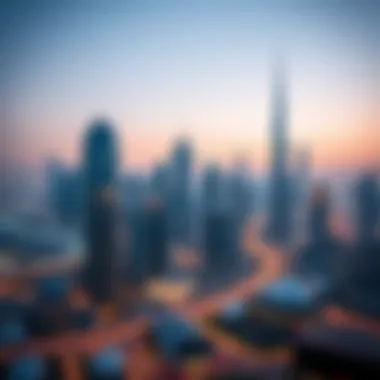
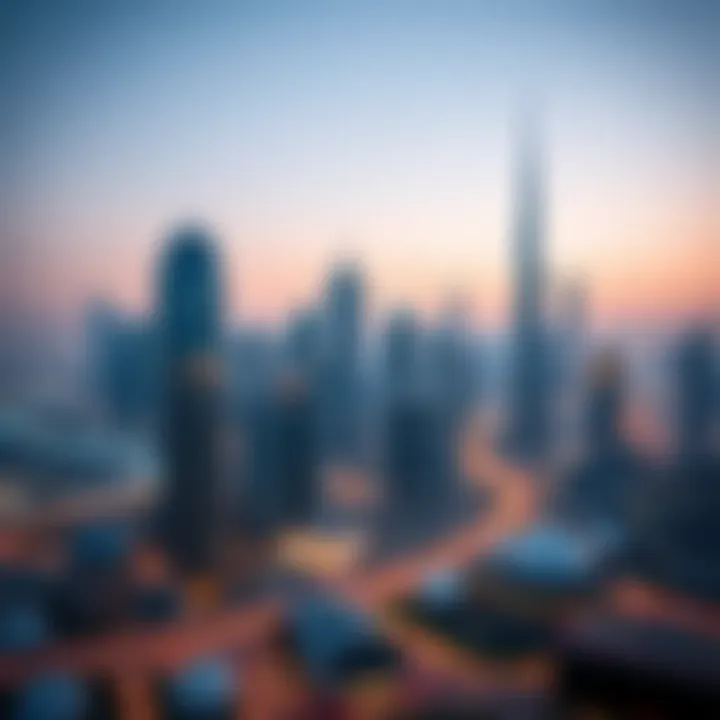
Intro
Dubai’s skyline is nothing short of a modern marvel, showcasing innovative architectural feats and a diverse range of structures that stretch toward the heavens. Among these, dome tower clusters stand out as symbols of both aesthetic allure and functional design. These unique configurations are not merely beautiful; they play a pivotal role in the dynamics of the city’s real estate market.
Dome towers, with their graceful curves and futuristic appeal, are reshaping how people view urban living. They blend traditional Islamic architecture with contemporary trends, resonating with both residents and investors. Because of this architectural fusion, they help to create a distinctive cultural identity, enhancing community ties while also contributing to the visual splendor of the city. Furthermore, the rise of these structures signals a broader trend in urban development, making them an important topic for anyone interested in Dubai’s property markets.
In understanding the impact of dome tower clusters, one must delve deeper into market trends, investment opportunities, and their role in shaping Dubai’s identity. This article aims to equip readers with critical knowledge, covering everything from current real estate pricing to what future opportunities may arise. Let's dive into the intricacies that define this fascinating aspect of Dubai's landscape.
Understanding Dome Tower Clusters
In the rapidly evolving architectural landscape of Dubai, dome tower clusters have emerged as significant landmarks that fundamentally shape both the skyline and the real estate market. These structures are not just visually impressive; they also embody a myriad of benefits and considerations integral to understanding the ongoing transformation in urban development. Recognizing their impact entails exploring the design innovations they bring, how they reflect cultural identities, and their ripple effects on market dynamics.
In an age where city aesthetics and functionality intertwine, dome towers serve a dual purpose, acting as both residential or commercial havens and emblematic representations of contemporary architecture. Their unique styling not only adds to the city’s visual allure but also attracts potential investors, eager to capitalize on a thriving market. The importance of this topic lies in its capacity to elucidate the intricate dance between architectural design and real estate trends—offering insights to professionals in the field who aim to navigate this vibrant landscape.
Defining Dome Towers
A dome tower can be characterized as a building structure topped with a dome, forming a distinctive silhouette in the skyline. In Dubai, such towers are often multi-functional, having spaces for living, working, and leisure within a single architectural framework. The defining feature, the dome, serves not only aesthetic purposes but also functional ones, such as improved wind resistance and natural lighting.
These towers can vary significantly in size and design, yet they typically share a few common characteristics that make them readily identifiable. The synergy between the round shape of the dome and the vertical lines of the tower itself facilitates a harmonious yet bold profile against the endless desert sky. While each structure may tell its own story, they collectively contribute to the larger narrative of urban sophistication and architectural ambition that Dubai represents.
Characteristics of Dome Tower Clusters
Dome tower clusters present several defining characteristics that set them apart from traditional high-rises. Understanding these aspects is crucial for anyone interested in the architectural symbolism and functional role they play in urban environments.
- Innovative Design: Many dome tower clusters exhibit pioneering architectural styles that challenge conventional forms. Their unique geometry allows for an engaging interplay between light and shadow, often creating stunning off-peak hours displays.
- Sustainable Elements: As awareness of environmental issues grows, many of these structures incorporate sustainable technologies. Examples include energy-efficient systems and the use of sustainable materials in construction, thereby aligning with global trends towards more responsible urban development.
- Mixed-Use Capabilities: A significant benefit of many dome towers is their ability to accommodate various functions. They can house businesses, apartments, and communal areas—thereby enhancing community engagement and utilization.
- Cultural Significance: These towers often draw inspiration from both Islamic architecture and modern trends, thus standing as symbols of cultural synthesis. Their design elements may reflect local heritage while simultaneously embracing forward-thinking ideals.
Understanding these characteristics is essential, especially for investors and realtors, as they can influence decisions related to property value and marketability. Ultimately, dome tower clusters are not merely buildings but represent a confluence of art, lifestyle, and economic opportunity in a city renowned for its innovation.
Architectural Significance
The architectural significance of dome tower clusters in Dubai stretches far beyond mere aesthetics. These structures represent innovative design thinking that marries functionality with artistry. The unique shapes of dome towers contribute to a skyline that is not only striking but also serves practical purposes. The integration of innovative engineering and local climate considerations has become paramount in their design. They are crafted to withstand both the heat of the desert sun and the unpredictability of sandstorms, showcasing an understanding of environmental challenges.
Design Innovations
Dome tower clusters embody cutting-edge design innovations that push the boundaries of traditional architecture. These towers often incorporate sustainable materials and smart technology, reflecting a shift towards greener building practices. The use of materials like glass and steel enhances durability while allowing for expansive, panoramic views of the city. Plus, the dome shape can facilitate efficient air circulation, which contributes to energy savings.
One notable innovation implemented in these designs is the use of modular construction techniques. By prefabricating components off-site, builders can reduce waste and accelerate timelines. Not only does this method decrease costs, but it also minimizes the environmental footprint of the construction process. This approach is crucial in a rapidly growing city like Dubai, where time is of the essence.
Additionally, the inclusion of advanced smart technologies ensures that residents enjoy modern amenities while enjoying privacy and security. Building management systems can optimize energy usage, monitor temperature, and enhance the overall living experience.
Cultural Reflections
The dome towers reflect more than just an architectural trend; they are laden with cultural significance. The form of the dome has historical roots in Middle Eastern architecture, providing a link between modern identity and traditional influences. It embodies a sense of grandeur and creates a unique narrative that resonates with both residents and visitors.
Incorporating elements of Islamic design, dome tower clusters present an aesthetic that honors cultural norms while appealing to a global audience. This blend of the contemporary with the traditional helps to establish a sense of place in a city that is constantly evolving.
Moreover, these structures act as cultural landmarks, serving as venues for community engagement. Spaces surrounding dome towers often include parks, marketplaces, and social areas, fostering interactions among diverse populations. This contributes to a rich community tapestry, reinforcing social bonds and enhancing cultural exchange.
"The design of dome towers is a symphony of technology and tradition, creating spaces that not only house people but also inspire them."
In turn, these towers draw attention from investors and potential residents, impacting the real estate market significantly. As Dubai continues to evolve, the architectural significance of these dome clusters will undoubtedly play a pivotal role in shaping the city’s character and identity.
Urban Planning and Development
Urban planning and development play a pivotal role in shaping the landscape of cities, particularly in dynamic environments like Dubai. As dome tower clusters emerge as icons of modern architecture, their integration into the urban fabric presents both opportunities and challenges, requiring meticulous planning and execution. This section lays bare the significance of urban planning concerning dome towers, focusing on various elements that enhance the efficiency and livability of the surrounding metropolitan areas.
Integration with City Infrastructure
The merger of dome tower clusters with existing city infrastructure is essential for optimizing urban functionality. Like the cogs in a well-oiled machine, these structures must mesh seamlessly with transportation, utilities, and public services. For instance, consider the roads and public transport systems that must handle increased foot traffic and vehicle load that comes with these towers. If not planned correctly, the streets might become a bottleneck, reducing accessibility and driving potential residents away.
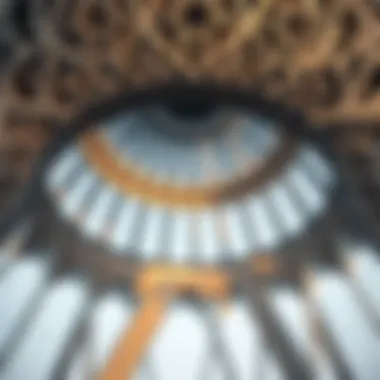
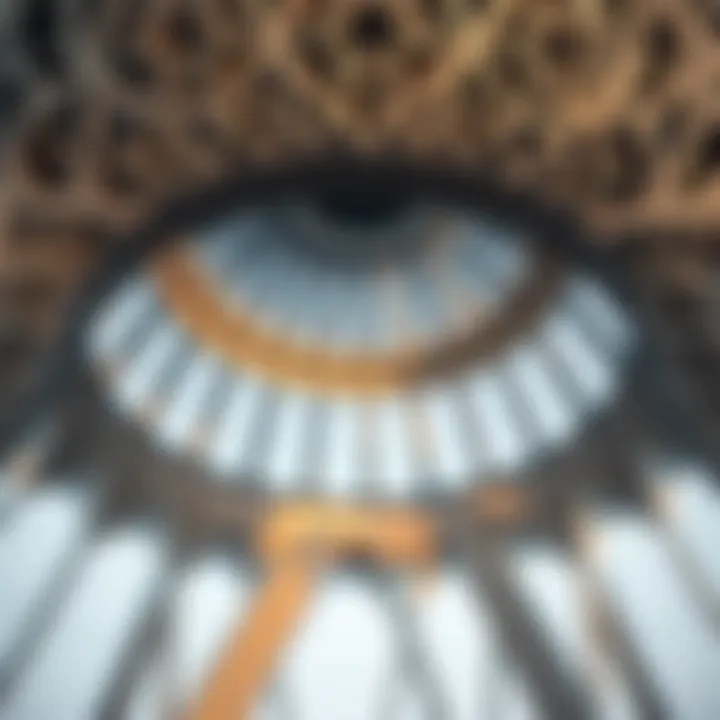
Dome towers often incorporate advanced technologies that contribute to making life smoother for users. Features like smart elevators that predict demand, energy-efficient systems, and integrated public transport links can elevate a building from simply a place to live or work to a convenient hub of activity. Moreover, sustainable practices in energy consumption can significantly bolster the city's green initiatives, aligning with eco-friendly urban planning goals.
In essence, the successful integration of dome towers with city infrastructure involves a holistic approach, ensuring that these distinct structures do not only stand out skyline-wise but also contribute positively to the urban ecosystem.
Impact on Surrounding Neighborhoods
Dome tower clusters leave a noticeable mark on their surrounding neighborhoods, influencing property values, social dynamics, and overall community well-being. As these clusters rise, they often attract new businesses, restaurant chains, and recreational facilities—consequently boosting the local economy. Yet, this influx is a double-edged sword; while it promises growth opportunities, it can also lead to gentrification, pushing out long-standing residents who may no longer afford the rising costs of living.
A prime example of this can be seen in areas like Dubai Marina, where the introduction of high-end developments has brought both luxury amenities and increased property prices.
"Dome towers can act as catalysts for change, though they hold the power to both enrich and disrupt communities."
Furthermore, the design of these structures often promotes community interaction by incorporating public spaces such as parks and plazas. When residents gather in these spaces, a sense of unity forms, thereby enhancing the quality of life. Ultimately, the impact of dome towers on surrounding neighborhoods is multifaceted, requiring careful consideration to ensure any change fosters community growth and retains local culture.
Market Trends in Dome Tower Developments
Dome tower developments have become crucial players in the dynamic landscape of Dubai's real estate market. Their unique architectural style and futuristic design not only enhance the skyline but also symbolize innovation and progress in urban development. Understanding the trends within this market involves dissecting demand and supply dynamics, as well as scrutinizing price fluctuations. As the city continues to grow, these elements play pivotal roles in shaping investment opportunities, which benefit investors and homebuyers alike.
Demand and Supply Dynamics
When we think of demand and supply in the dome tower market, it’s much like a balancing act between what buyers want and what developers provide. Demand for these structures has surged for a variety of reasons. In a city that thrives on luxury and opulence, dome towers offer a unique selling proposition that is difficult to ignore. They are not just homes; they are landmarks. People are drawn to their innovative designs, panoramic views, and state-of-the-art amenities. As a result, the influx of expatriates and high-net-worth individuals seeking lavish lifestyles drives demand.
On the flip side, there's also the challenge of supply. While many developers are eager to jump on the dome tower bandwagon, the complexities involved in constructing such intricate designs can cause a bottleneck. Zoning laws, construction regulations, and the availability of materials can all factor into how quickly these structures emerge. Additionally, as the land in prime areas becomes scarcer, the competitive edge becomes sharper.
In summary, the interplay of robust demand and the challenges of supply creates a compelling narrative. Investors need to keep an eye on the trends in this space, as they can affect not just short-term profits but also long-term viability in the market.
Price Fluctuations
Price fluctuations in the dome tower segment can be as unpredictable as the weather in Dubai. Historically, these prices have tended to reflect the overall economic health of the emirate. When the economy is booming, the market sees a spike in property prices. However, economic downturns will often lead to a softening of prices. Understanding these fluctuations is key for anyone looking to invest or settle in one of these architectural gems.
Currently, factors such as international investment, global economic conditions, and local real estate regulations all contribute to the ups and downs of prices. For instance, a sudden increase in foreign investment can cause property prices to surge, as demand escalates. Conversely, regulatory changes that restrict foreign ownership can have an immediate downward spiral effect on prices.
- It is important for investors to consider:
- Market Timing: Knowing when to buy or sell can significantly affect returns.
- Location Analysis: Properties in prime locations typically experience steadier price growth.
- Economic Indicators: Stay informed about the Dubai economy and global markets.
By keeping a keen eye on these factors, prospective buyers and investors can navigate the choppy waters of price volatility and make informed decisions that can lead to substantial returns.
"In the real estate game, knowledge is your greatest asset. Stay informed to stay ahead."
As Dubai continues its journey of architectural evolution, dome tower clusters stand at the forefront, shaping not only the physical landscape but also the real estate market dynamics.
Investment Opportunities
The rise of dome tower clusters in Dubai has opened up a diverse array of investment opportunities for those queuing up to get a slice of the pie in this bustling market. With time, the emphasis has shifted from merely constructing lavish buildings to creating environments that foster economic prosperity and communal harmony. Investing in dome towers is not only about the capital laid down; it also involves envisioning future trends and potential returns.
One aspect that makes dome tower clusters particularly attractive is the varied potential for rental income. This can be especially appealing for expatriates and investors looking to capitalize on the lucrative short-term rental market. Dome towers often house high-end amenities and aesthetic designs, which draw a clientele willing to pay a premium for the experience. For example, a well-situated dome tower with stunning views of the Dubai Marina can command rental prices that reflect its exclusivity and desirability. Investors looking to make their mark must consider the following:
- Location: Proximity to major business districts and leisure spots can significantly influence rental demand.
- Amenities: Properties equipped with modern facilities such as gyms, pools, and concierge services tend to attract higher rents.
- Market Trends: Being attuned to the ebb and flow of the rental market is crucial for maximizing returns.
"Investment is about trading time for money. In real estate, the essence is understanding that time can be an ally or an adversary."
Rental Income Potential
When examining the rental income potential, one cannot overlook the high occupancy rates these dome tower clusters boast. Factors like seasonal tourism and the consistent influx of working expats contribute heavily to stable rental yields.
Consider the scenario where an investor decides to purchase a unit in one of the prestigious dome towers like the Burj Al Arab. The views and five-star amenities naturally cater to the luxury segment, resulting in rental rates that can reach astonishing heights during peak seasons. Moreover, strategic marketing and proper management can elevate average occupancy figures beyond the conventional averages in Dubai.
The growing trend of work-from-home arrangements has also seen a shift in demand. Many residents are seeking spacious, multifunctional living spaces that can serve both as home and workplace. As such, units with dedicated workspaces can often command a premium.
Capital Growth Prospects
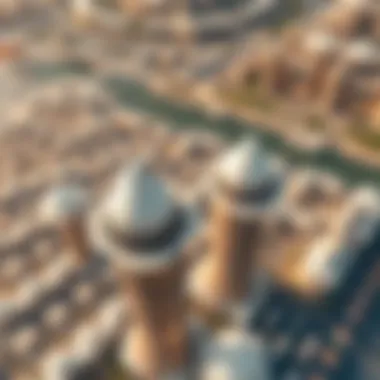
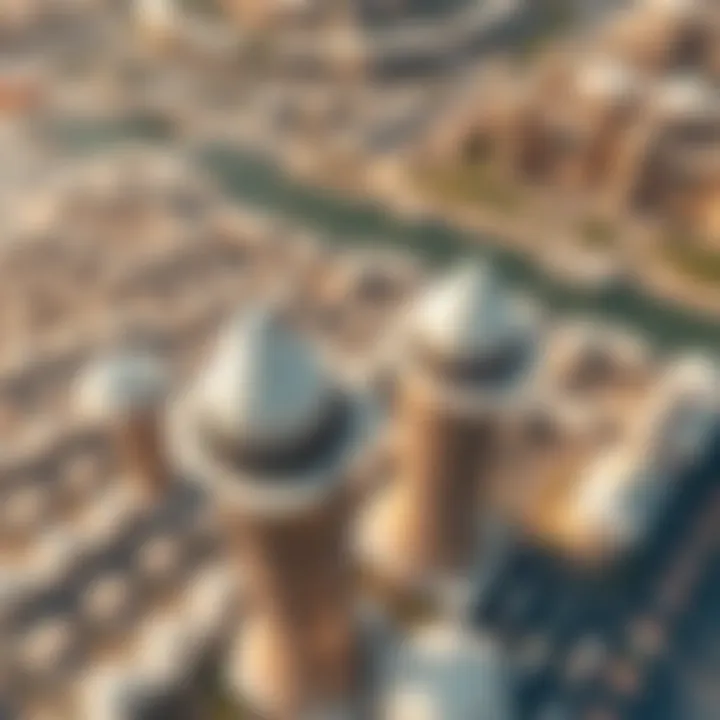
In addition to steady rental income, investing in dome towers presents enticing capital growth prospects. Over the years, Dubai's property market has seen fluctuations, but developers' focus on distinctive architecture like dome towers can yield impressive long-term appreciation.
Investors must keep an eye on factors such as:
- Future Developments: Anticipating the completion of transport links or malls in proximity to the dome towers can affect future property values.
- City Planning Initiatives: Dubai’s ongoing urban development plans hint at potential hotspots.
- Cultural Significance: As the city continues to brand itself for tourism and business, properties that contribute to Dubai's skyline are likely to see an increase in valuation.
Ultimately, these unique structures are more than just real estate; they're emblematic of Dubai's ambitions. Potential investors should not only factor current market conditions but also consider the socio-economic landscape that shapes future demands. Thus, investing in dome tower clusters is both a personal journey and a calculating financial expedition, poised to carve out a niche in a vibrant cityscape.
For further reading on investment in Dubai's real estate, check resources like Wikipedia and Britannica.
Challenges in Dome Tower Development
Dome towers have become a striking feature in Dubai's skyline, boasting both aesthetic appeal and investment potential. However, the path to erecting these iconic structures is not without its obstacles. Understanding the challenges faced in dome tower development is essential, as it sheds light on the complexities that can impact the real estate market. This section delves into various hurdles, from regulatory barriers to the financial constraints associated with construction.
Regulatory Hurdles
When it comes to the construction of dome towers, navigating the regulatory landscape can feel like trying to solve a Rubik's cube with a blindfold on. The approval process involves multiple agencies, each with its documentation and requirements. The local government's planning legislation often dictates how high a building can be, what materials can be used, and even the architectural style that must be adhered to. Such guidelines are not just red tape; they reflect cultural sensitivities and regulations aimed at ensuring safety and sustainability.
- Permits and zoning laws can significantly delay projects, creating a bottleneck for developers eager to get started.
- Additionally, changes in regulations can occur, especially in response to public sentiment or environmental concerns, which may require developers to go back to the drawing board.
Investors must keep their ears to the ground regarding any shifts in these regulations. Failure to comply may lead to fines, or worse, a complete halt of their project.
Construction Costs
Building a dome tower is often likened to creating a masterpiece but with a hefty price tag attached. The unique architectural form and innovative engineering techniques necessary for dome structures can inflate costs considerably. While the end product may be visually stunning, the journey to that point can be financially daunting.
Below are some contributing factors to the high construction costs:
- Specialized Materials: Dome towers often require custom materials that are not only expensive but also challenging to source. This can lead to delays and additional costs.
- Labor Expertise: Craftsmen skilled in dome construction are not as common as other trades, leading to increased labor costs.
- Technology and Equipment: The advanced technology required for erecting dome structures comes with its own set of financial burdens, adding to the overall budget.
"Managing construction costs while maintaining quality can feel like walking a tightrope—one misstep and everything could come crashing down."
Case Studies of Notable Dome Towers
Diving into case studies of dome towers in Dubai serves not only to appreciate their unique architectural designs but also to understand their impact on the urban landscape and the real estate market. These case studies illuminate how specific projects have shaped Dubai’s reputation, attracting investors and residents alike. By analyzing these notable structures, we can discern key elements that contribute to their appeal, alongside potential considerations for future developments.
Iconic Structures in Dubai
When one mentions dome towers in Dubai, several unique structures come to mind that have made their mark on the skyline. Among them is the Burj Al Arab, a sail-shaped hotel that embodies luxury and sophistication. Its striking design is a testament to the innovation that defines Dubai. Another significant structure is the O-14 Tower, which features a distinctive perforated façade, allowing natural light to pour in while maintaining privacy. This demonstrates how aesthetic appeal intertwines with functional design.
Additionally, the The H Dubai showcases a blend of cutting-edge technology with remarkable artistry, making it a prime example of how dome shapes can be adapted to contemporary needs. Moreover, the Dubai Frame, while not a traditional dome tower, integrates dome-like features that bridge the past with the future, providing unparalleled views of old and new Dubai. Each of these towers not only adds to the aesthetic of the skyline but also plays a pivotal role in the surrounding community, often serving as cultural landmarks or hubs of activity.
Each of these iconic structures highlights crucial benefits crucial for real estate investors and urban planners:
- Distinctive Identity: They create a strong visual identity for Dubai, enhancing its status as a global city.
- Tourism and Visibility: Their unique designs attract tourists, contributing significantly to the local economy.
- Investment Potential: The value associated with these buildings continues to rise, promising high returns for investors.
Dome towers, therefore, are not just buildings; they are capital-intensive investments that magnify the vibrancy of their surroundings.
Lessons from International Examples
Looking beyond Dubai, international dome structures offer invaluable lessons for future developments. Take the Dome of the Rock in Jerusalem; its design is rooted in historical significance and spirituality. This suggests that an engaging architectural narrative can deeply resonate with the local populace and beyond.
Another notable example is the Gherkin in London, which utilizes sustainable design principles and has become a symbol of modern architecture. This project exemplifies the importance of marrying aesthetic ambitions with environmental considerations, a key element in today's market where sustainability is paramount.
Here are a few takeaways from these international examples that may apply to Dubai’s ongoing development of dome tower clusters:
- Cultural Integration: Ensuring that structures reflect local identity can enhance community acceptance.
- Sustainability: Integrating eco-friendly technologies into designs can not only reduce costs but also attract a growing demographic that values sustainability.
- Adaptability: Making buildings flexible in their use can ensure they remain relevant as market demands shift.
In summation, the study of local and international dome towers underscores their multifaceted roles—beyond mere functionality. As Dubai forges ahead in its architectural endeavors, the insights gleaned from these case studies will be pivotal in shaping the emirate’s ongoing evolution.
"Dome towers are not only part of a skyline; they reflect a city’s ambition, spirit, and vision for the future."


Investors, realtors, and community members alike should consider these insights as they navigate the complex landscape of Dubai’s thriving real estate market.
Community Impact
The emergence of dome tower clusters in Dubai is not just about breathtaking architecture; it has profound effects on local communities. These structures shape how people interact and engage with their environment, creating vibrant social spaces that contribute to the city's identity. Understanding the community impact is crucial for investors and urban planners alike, as it ensures that future developments enhance rather than hinder the social fabric of the city.
Social Spaces and Interactions
Dome towers serve as more than just residences or offices; they become focal points for social interaction. Their design often incorporates communal areas such as gardens, plazas, or recreational facilities, fostering a sense of belonging among residents. For instance, the spaces between tower clusters are often used for outdoor markets or cultural events, bringing together people from diverse backgrounds. This kind of engagement is not merely beneficial; it's essential for community cohesion.
- Key Examples:
- Many dome towers in Dubai have designated areas for social activities, allowing residents to connect over common interests.
- Various events like art exhibitions or food festivals are frequently organized in these spaces, promoting cultural exchange.
Furthermore, these social hubs can boost local businesses, creating opportunities for entrepreneurs. Coffee shops and boutiques sprout up around these developments, catering to both residents and visitors. When people gather in these communal areas, it multiplies the chances for spontaneous interactions and collaborations, further enriching the community.
"A thriving community doesn’t just build itself around homes; it builds itself around shared experiences and interactions. Dome clusters facilitate that pretty well."
Creating a Sense of Identity
The dome towers' architectural uniqueness contributes significantly to Dubai’s skyline and the communities they are a part of. They serve as emblems of innovation and prosperity, instilling pride among residents. The striking dome shapes, often inspired by local cultural motifs, make these buildings not only visually stunning but also culturally meaningful.
- Cultural Significance:
- Incorporating traditional elements in their design can help create a bridge between modernity and heritage, enabling residents to feel connected to their roots.
- For expatriates, these towers can serve as landmarks, making the unfamiliar feel more like home.
This aspect goes beyond aesthetics; it creates a narrative of unity and celebration within the community. By living or working within these structures, individuals forge a shared identity that resonates with the city’s overall ethos. For investors, understanding this community identity can guide marketing strategies and enhance the appeal of their projects.
In summary, dome tower clusters do more than contribute to the skyline; they foster community spirit and create a sense of belonging. Investors should keep an eye on these elements as they can elevate the desirability of properties and ensure long-term value in an ever-evolving market.
Future Prospects for Dome Tower Clusters
The discussion around the future prospects for dome tower clusters is essential, particularly in a city such as Dubai, which is famed for its innovative architectural feats. As the skyline continues to evolve, the implications of these structures extend beyond aesthetics to affect various facets of urban life and the real estate market. Dome towers must not only meet the current demands of architecture but also adapt to future needs in terms of sustainability, community, and economic feasibility. This section explores what the future holds for these remarkable structures, encompassing design trends and environmental considerations.
Predicted Trends in Design
Designing dome tower clusters isn't just about standing out in the skyline; it's about creating a holistic experience that appeals to residents, businesses, and tourists alike. Future designs are likely to be influenced by a few key trends:
- Flexibility: As lifestyles shift, the architectural world must embrace versatile spaces. Towers may feature adaptable interiors that allow residents or businesses to reconfigure their spaces easily.
- Integration of Technology: Smart buildings are the wave of the future. With the rise of the Internet of Things (IoT), future dome structures could incorporate advanced technologies that enhance living and working experiences. Imagine systems that optimize energy use or automate room settings based on occupant preferences.
- Cultural Context: As Dubai seeks to maintain its cultural identity, future dome towers may reflect local artistry and traditions. This can be achieved through materials, motifs, and structural elements that resonate with the Emirati heritage.
With these design trends in mind, developers and architects are setting the pace for how dome towers will influence urban living.
Environmental Considerations
In a world increasingly aware of climate change and sustainability, dome tower clusters in Dubai face pressure to incorporate eco-friendly practices in their design and functionality. Given the region's climate, the potential for sustainable innovations is vast. Here are some significant measures that could come to define future developments:
- Energy Efficiency: Designing dome towers to maximize natural light and reduce reliance on artificial lighting can significantly lower energy consumption. Utilizing solar panels or green roofs can add to sustainability goals as well.
- Water Conservation: Future developments may focus on water recycling systems to ensure minimal use of this precious resource. Integration of smart technologies that monitor and manage usage can help mitigate waste.
- Material Sourcing: Choosing local and sustainable materials can reduce the carbon footprint associated with construction while also supporting local economies. In a city like Dubai, where luxury often meets opulence, there is a compelling opportunity to balance aesthetics with ecological responsibility.
In summary, the future of dome tower clusters in Dubai looks promising, with innovative designs that marry modern technology with cultural elements while addressing pressing environmental concerns. It’s a delicate balancing act, but one that offers significant rewards, not just for developers but for the community at large. Investing in structures that are adaptable, sustainable, and reflective of local culture might pave the way for a vibrant urban future.
Culmination
The examination of dome tower clusters in Dubai reflects broader themes of architectural innovation, urban development, and economic investment. This article underscores the significant role that these structures play not only in shaping the skyline but also in influencing real estate trends and community dynamics within the city.
Summary of Findings
Dome towers symbolize a fusion of aesthetic appeal and functional design, often standing as beacons of luxury and modernity. The analysis has highlighted several key points relevant to investors and stakeholders:
- Architectural Impact: Dome towers bring a unique visual identity to Dubai's skyline, attracting attention from tourists and residents alike.
- Real Estate Dynamics: The clustering of these structures often increases property values in the surrounding areas due to demand for panoramic views and premium amenities.
- Cultural Relevance: These towers do not merely represent architectural marvels; they embody cultural narratives and aspirations of the region, enhancing the Dubai brand on a global scale.
Final Thoughts on Investment and Development
As Dubai continues to evolve, the implications for real estate investors are significant. The demand for properties in dome tower clusters seems poised to remain strong as the city emphasizes sustainability and modern design. Here are some considerations for potential investors:
- Long-term Value: Investing in dome towers may provide robust returns given their desirability and the overall growth of Dubai’s infrastructure.
- Market Awareness: Understanding the local market and staying informed about emerging trends is crucial. Fluctuations in property prices can often provide opportunities for savvy investors.
- Environmental Trends: New developments are likely to incorporate eco-friendly designs and technologies, making properties in dome clusters more attractive to a growing demographic of environmentally-conscious buyers.
In summary, dome tower clusters represent much more than just real estate assets; they are integral to the identity and vibrancy of Dubai. For investors, the landscape is rich with opportunity, provided that they navigate it with foresight and market insight.



